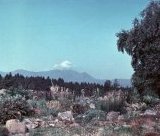ORNAMENTAL PLANTS IN THEIR NATURAL HABITATS
D. The Russian Federation
The northern slope of the Greater Caucasus Range is situated
in the Russian Federation and according to Takhtajan this territor
is a part of the Caucasian Province. The Teberda Reserve occupies
the northern slopes of the Central Caucasian Range, and the southern
part of this reserve is the more interesting for a field trip. The
roads and paths from Teberda lead southward along the right bank of
the Teberda River to the Klukhor Pass at 2,816 m (9,236 ft). To the
left of the river lie the mountain slopes of the Small and Great
Khatiparas which are crowned with rocky peaks. Along the Klukhor river,
the road and slopes become steeper. Many ornamentals favour these grassy
slopes, occupied by widespread plants as well as by some 200 species endemic
to the Caucasus. Scabiosa caucasica, Anthemis rigescens, Lathyrus cyaneus,
and Bistorta carnea are most conspicuous when in flower. Gadellia
lactiflora frequents forest edges, while Hedysarum caucasicum
and Pulsatilla albana or pasque flower adorn subalpine meadows.
Northern slopes are studded with the bright red-flowered Geranium
sanguineum and the showy white inflorescences of Anemonastrum
fasciculatum.
Rhododendron caucasicum intrudes into the alpine
zone up to 2,500 m (8,802 ft). Crocus scharojanii produces
fascinatingly bright orange flowers during the late summer; it grows
on gravelly substrates and loose grassy turf. Although rare elsewhere
in the Caucasus, Crocus scharojanii is abundant here and also on
Mt. Oshten and on the slopes adjacent to El’brus. The rocky habitats
and alpine meadows around the "Northern Shelter" camp are
covered by low cushion-formers, such as bellflowers, gentians, saxifrages
and stonecrops. The road dips sharply downward to the Black Sea coast
after leaving the Klukhor Pass (Klukhorskiy Pereval) and Klukhor Lake.
Kabardino-Balkaria, another mountainous area in the North Caucasus,
extends to eastern Teberda. Mt. El’brus, which is the highest peak of
the Greater Caucasus, rises in the southern part of Kabardino-Balkaria.
It has two nearly equal summits (5,642 m/18,510 ft and 5,621 m/18,441ft)
covered with deep snow and surrounded by glaciers. The alpine meadows
are mostly clothed in turf-forming sedges, fescues and the like.
Gentiana angulosa, G. dshimilensis, Primula ruprechtii, P. meyeri
and P. algida are among the most notable and beautiful plants.
The cushion-forming species of Cerastium and Minuartia (M.
biebersteinii, M. bushiana, M. oreina) thrive on gravelly substrates
and on rocky slopes. The large blue-flowered Campanula anomala and
the white-flowered Dryas caucasica are attractive in their flowers
and fruits. Tall plants such as Aquilegia olympica and Trollius
ranunculinus are associated with soils rich in organic matter, but
Sibbaldia parviflora and Pedicularis caucasica form bright
colour splashes on more sterile, rocky soils.
The Caucasian flora is very rich in ornamental species, but because of
the high mountainous terrain, poor roads and the inaccessibility of many
areas, it is sometimes difficult to enjoy the beauty of this flora.
Therefore, one should visit the Bakuriani Botanical Garden (2,000 m/6,560 ft)
of the Institute of Botany (Tbilisi, Georgia), where many valuble Caucasian
plant species can be seen in cultivation. This garden has Caucasian species
from the western and eastern parts of the range, including many rare species
that grow wild in the less accessible areas.
|




